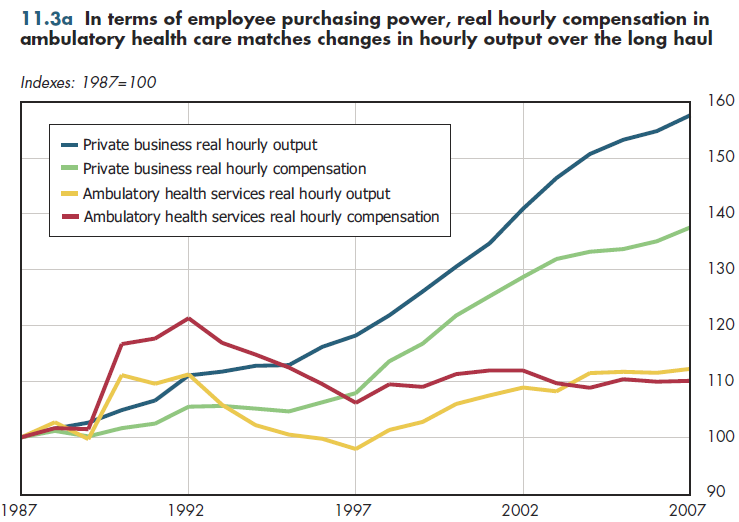Download PowerPoint versions of both figures.
11.3 Employee Compensation in Ambulatory Health Sector Grew Slowly
Summary: Real compensation per hour has increased more slowly in the ambulatory health sector than in the rest of the economy.
In terms of worker purchasing power, real (inflation-adjusted) hourly compensation in ambulatory health care has matched changes in hourly output over the long haul (figure 11.3a). This might seem unremarkable except that it deviates from the experience in the private sector generally. In most of the economy, inflation-adjusted hourly compensation increased in the 20 years starting in 1987. However, it did not rise as quickly as changes in real hourly output over the same period.

In ambulatory health services, real hourly compensation rose far more rapidly than either hourly compensation in the rest of the economy or hourly output in that industry. Subsequently, however, compensation steadily declined from its "excess" level in 1992 to a level more comparable with the change in hourly output by 2007. This is more in line with conventional economic theory that wages generally will reflect the productivity of labor. However, this compensation index measures wages in terms of worker purchasing power (as previously written, by dividing by the PCE price deflator to remove the effects of general inflation).
An alternative approach divides by the price of business output. This reflects the price of what a worker can produce in an hour. Doing this (figure 11.3b), the private sector shows a much tighter fit between changes in hourly output and what is paid to labor (although in recent years, compensation again has begun to lag behind higher productivity).

The facts in the ambulatory care sector are quite different. Although labor productivity increased by 10 percent over this period, hourly compensation declined by approximately the same amount. This reflects the fact that prices in the ambulatory health care sector have outpaced worker productivity gains. If prices rose in parallel with productivity gains—as apparently they do in the private sector generally—then real compensation for ambulatory services workers would have risen 10 percent also.
Briefly, real hourly compensation has risen less rapidly in the ambulatory health sector than in the rest of the economy. This reflects the reality that hourly productivity gains in that sector likewise have been less.
Downloads
References
- Author's calculations.
- Department of Labor. Bureau of Labor Statistics.
Content actions
Give feedback:
Add module to:
Reuse / Edit:
Twin Cities Campus:
- © 2012 Regents of the University of Minnesota. All rights reserved.
- The University of Minnesota is an equal opportunity educator and employer. Privacy
- Last modified on Sep 26, 2013 2:11 pm -0500









